We're an affiliate
We hope you love the products we recommend! Just so you know, we may collect a share of sales or other compensation from the links on this page at no additional cost to you. Thank you if you use our links, we really appreciate it!
Having multiple pets in your home can be an enriching experience, especially when your dog and cat get along together.
The relationship between your two furry pals can be fulfilling but sometimes the dog may engage in gross behaviors such as sampling the content in a dirty litter box.
As a responsible pet parent, you need to know how to keep a dog out of the litter box for the best interest of your pets and hygienic purposes at home.
This post presents a well-researched guide, by exploring the reasons why dogs are drawn to kitty litter, the potential dangers, and what you can do to keep your dog away from the litter box.
Why do Dogs Like Cat Litter Boxes?
If you live in a multi-pet home, you probably know how dogs can scavenge on the goodies from your cat’s litter box.
Here are some of the reasons why your dog may love the litter box area:
1. It smells good
The main reason why dogs love litter boxes is because they smell good to them, and the content is probably yummy too.
Dogs have a very keen sense of smell and they do lots of things based on their scent perception. The nasties left behind by your cat in the litter box can carry traces of cat food scent.
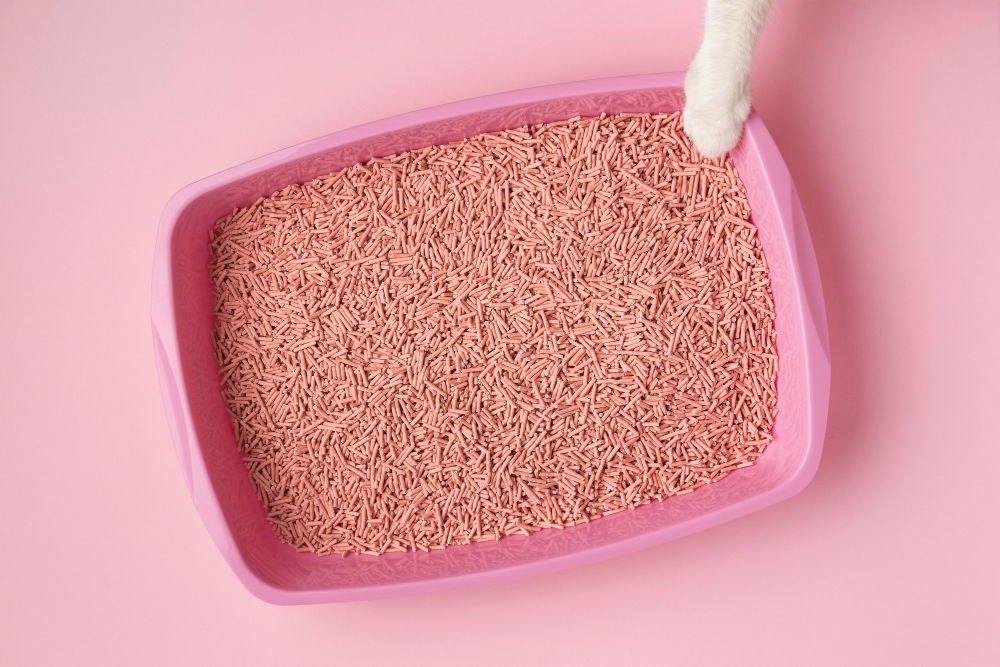
You may wonder how the cat’s droppings smell good. As you may already know, cat food is formulated with a higher animal-based protein than dog food.
Most cats may fail to digest the food, meaning that they can leave droppings with small traces of meat flavor and scent.
It is these protein-rich nutrients that may be appealing to dogs, making them dig out the litter for some extra snacks for the day.
2. Curiosity
Dogs may raid the kitty’s litter box out of curiosity. If your dog is bored, they may get into the cat’s litter box to explore the content for fun.
Digging into the litter to unearth clumps of cat poop can be rewarding for dogs and it also adds a little excitement to calm boredom.
3. Behavioral problems
Some dogs have developed the unfortunate habit of feasting on the stool also known as coprophagia, including cat poop. This may sound disgusting, but some dogs actually enjoy snacking on cat droppings, and it’s a habit they cannot easily get over.
Dogs can develop this problem because every time they dig into a dirty litter box, they seem to get a ‘reward’. This motivates the canines to continue digging into the area for more exciting delights.
4. Wrong potty training
The other reason why your dog may seem to enjoy snacking on kitty poop is that you used the wrong approach to potty train them.
If you normally punish your dog for having an accident on the floor, they will try to hide the evidence by eating the poop.
The moment your furry friend discovers the ‘good’ taste of fecal matter, they will develop a liking and spread their mouth to the cat’s litter box.
Yelling, scolding, or punishing your beloved pup physically are not good techniques for teaching them housebreaking rules.
We suggest that you positively potty-train your dog by redirecting unwanted behavior and encouraging positive conduct with rewards.
5. Due to stress and anxiety
Some dogs are likely to eat cat poop due to isolation, stress, and anxiety. If you’ve left your dog alone at home for extended periods, they may decide to dig out cat poop from the litter box because they have nothing else to do.
This can be a coping mechanism to get relief from emotional distress. Other signs of anxious dogs include pacing, excessive barking, destructive chewing, and biting.
6. Underlying medical conditions
Some dogs may feast on cat poop as a sign of underlying medical conditions. Even though this is not a common reason for this behavior, it tends to occur due to malnutrition.
If you feed your dog a diet that does not meet all their nutritional needs, then they may end up with nutritional deficiencies.
Your vet will diagnose the dog for any underlying condition and recommend an appropriate diet to supply the needed nutrients and minerals.
Potential Dangers of Dogs Accessing the Litter Box
Dogs who access the cat’s litter box are not only at risk of ingesting cat poop, they are also at another risk of eating kitty litter.
There exist several kitty litters ranging from clumping, non-clumping, diatomaceous earth, tofu, and crystal, to silica litter.
High-quality cat litter is non-toxic to dogs, but they pose sufficient risk to your dog when ingested together with cat poop.
Health Risks for Dogs
Generally speaking, your dog may not get subjected to greater risk when they taste a tiny portion of content from the cat box.
1. Gastrointestinal problems
Some dogs may have symptoms like vomiting and diarrhea after eating little cat poop while others may not show immediate impact.
You should however know that cats are prone to carry internal parasites in their droppings that can be transferred to the dog’s gastrointestinal tract when ingested.
Dogs who ingest a huge portion of cat stool and litter are at a greater risk of suffering digestive upset and intestinal blockage.
Serious blockage may cause distress along the GI tract, diarrhea, abdominal distention, vomiting, excessive drooling, and other severe problems.
2. Dental problems
Chewed cat litter can gather around your dog’s gums and teeth exposing germs around the sensitive tissues.
The acid in the cat’s urine together with the rough texture of kitty litter can erode the dog’s teeth enamel causing mechanical damage and dental fractures.
Toxoplasma parasites in cat stool and germs in cat urine can also cause bacterial infections in your dog’s mouth.
This may result in bad breath (halitosis), dental decay, and eventual teeth loss, especially if you don’t brush your pup’s teeth that often.
3. Constipation
Dogs may risk having constipation when they ingest large amounts of dry kitty litter. This is because the litter particles are largely dry and they require water to move through the dog’s digestive system.
Signs of constipation in dogs include infrequent bowel movements, straining to poop, and unwillingness to eliminate waste.
Mild cases of constipation in dogs may be solved on their own, but severe cases will require intervention from your vet.
Your vet may prescribe an enema procedure, by injecting warm water through the rectum to loosen dry feces.
Risks for The Cat
Your cat may also be disadvantaged by your dog’s presence around the litter box area. Many cats may become nervous and avoid using the litter box when discovering the dog’s presence in the place.
Cats are territorial, and they may sink into constant worry when their barking housemates intrude into their spaces.
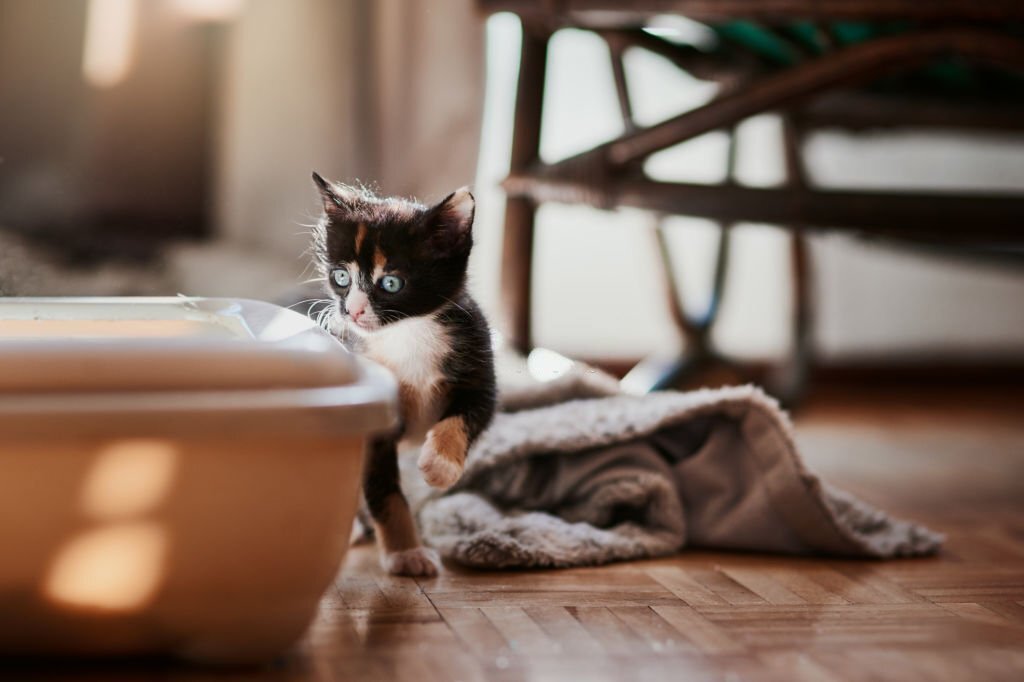
Affected cats are also likely to sink into stress and anxiety because of the dog’s presence in the litter box area.
This will disrupt the cat’s routine of using the litter box and encourage them to eliminate in inappropriate areas.
Household Hygiene Concerns
- When your canine friend digs into the cat’s litter box in search of some delights, they may end up creating a messy situation in the house.
- The dog will disrupt the area by scattering litter throughout the walkways and spreading cat droppings around the house.
- Dogs interact with the environment by sniffing and licking. They may end up sticking cat feces on various surfaces in the house after litter-snacking.
- This will create an unhygienic environment for everyone at home because the cat’s stool may contain dangerous parasites and germs, with the possibility of infecting both pets and humans.
- Additionally, dogs who access the cat’s litter box are likely to unclamp the litter to spread an unpleasant odor in the house.
How To Keep a Dog Out of The Litter Box
Many pet parents have encountered a hard time trying to stop their canine friends from accessing the cat’s litter box.
This is because dogs have a very keen sense of smell and they can get a whiff of a ‘snack’ every time your feline friend drops something in the litter box.
But with the right techniques, you can do something to keep your canine friend off the cat’s litter box. The following are several ways that may work wonders when done correctly:
1. Clean your cat’s litter box
There’s no better way to keep your dog off the litter box than to keep it clean all the time. Make sure to clean the litter box regularly to prevent your pup from sniffing out the goodies.
Ideally, you should scope the clumped litter immediately after your cat uses it, but this may need you to keep a constant look into your cat’s toilet routine.
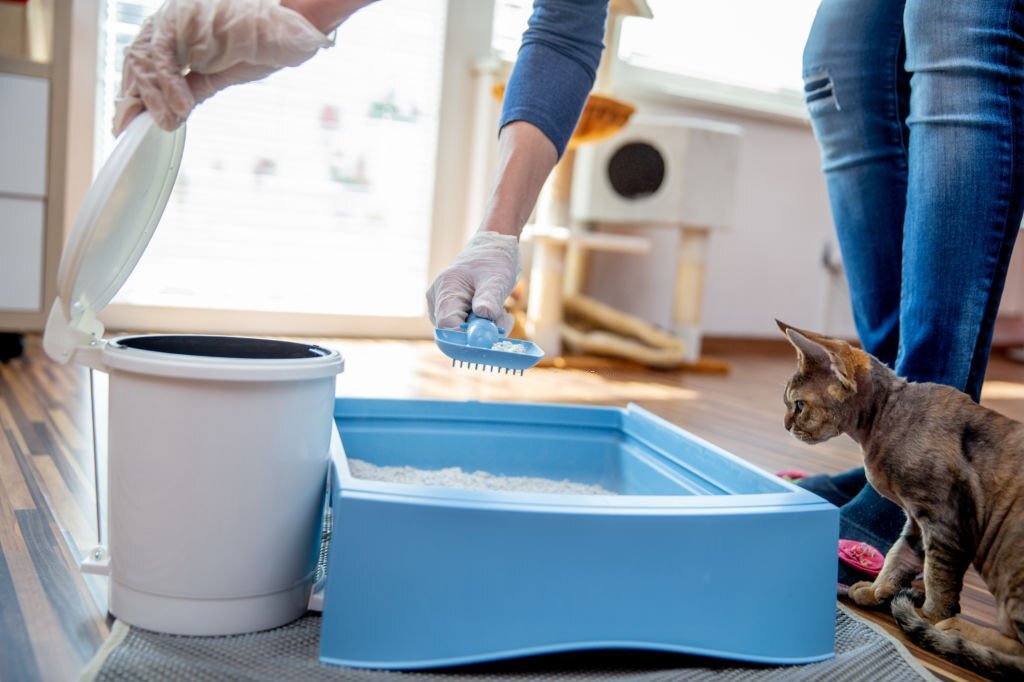
But with a tight schedule, you may not be at home always to clean the litter box in time. We suggest cleaning the box twice a day as part of your routine.
2. Train your dog
As you employ the other strategies to keep the dog out of litter boxes, don’t forget to train them to avoid certain areas of the house.
Start by teaching your dog the ‘drop it’, ‘leave it’ or ‘stop it’ commands. Have a bunch of high-value food rewards for your dog ready before commencing the training sessions.
When your dog walks towards the cat’s litter box, come on their way and give them a ‘stop it’ command. If you catch your dog in the act of feasting snacks from the litter box, give them a ‘leave it’ command, and encourage them to drop what they’re holding.
Reward your pup with tasty treats if they hear and respond to the commands positively. Repeat the command with a firm voice if they ignore you and try to redirect them to the right channel.
With patience and consistency, your canine buddy should be able to follow suit by picking up your commands.
Do not be discouraged because this training might take weeks or even months depending on how far your dog drifted from the norm.
Be careful about when to stop the training because you need to be sure that your dog won’t walk into the kitty’s litter box even when no one is at home.
3. Place the litter box in a strategic area
If your canine friend has easy access to the cat’s litter box area, then you can be sure they’ll be tempted to dig into the unhealthy snacks.
One of the best solutions to consider is to place the litter box in a convenient area for your cat, but it should be unreachable to the dog.
You can consider placing the litter box on an elevated platform such as having it on a table. We suggest doing this only for cats who can climb at ease.
If your cat needs extra help to climb the table, you can add a ladder to the table or place a cat tree beside it.
4. Use a pet gate
Installing a dog gate may help keep the dog away from the cat litter area if it is placed in a dedicated room.
Most felines have no problems navigating through a dog gate but they should have smaller openings for the dog to pass through.
Installing a pet gate doesn’t have to be costly or complicated. You can find good temporary options that still get the job done.
The challenge of using pet gates is that bigger dogs can jump over them and access the forbidden area with ease.
5. Consider automatic litter boxes
If you cannot keep up with the schedule of cleaning traditional litter boxes, you can consider investing in an automatic cat litter box.
These automated cat litter boxes have self-cleaning mechanisms which gather waste in an enclosed receptacle, every time your cat finishes their business.
Self-cleaning litter boxes may be costlier than regular ones, but they offer a convenient solution to keep dogs away from forbidden goods.
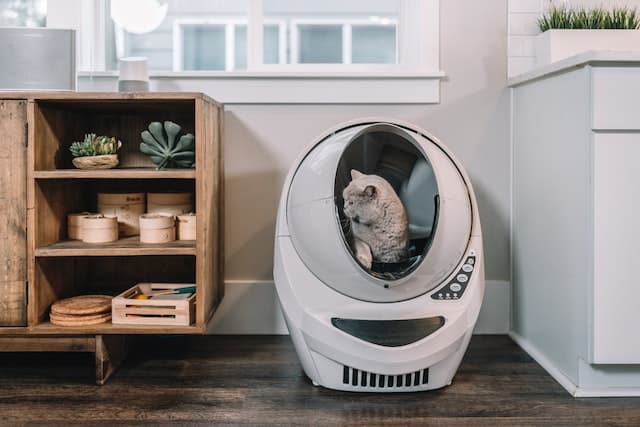
Some cats may get nervous about using these automated boxes because of the raking noise created during the self-cleaning mechanism.
If your dog is highly addicted to eating cat poop, they may be fast enough to get there before the self-cleaning action begins.
If you decide to go with this option, we suggest that you pick up something that will actually work.
6. Consider a dog-proof litter box
Dog-proof litter boxes have small openings at the top/sides to prevent dogs from sticking their heads into the litter area.
These litter boxes may work to stop large dogs from sampling the content but they may not work for small breed dogs.
Some dog-proof litter boxes have the added bonus of preventing your feline friend from tracking litter, therefore keeping the home clean.
A good way to keep your dog away from the forbidden goods is by enclosing a store bought litter box or making one for yourself.
7. Provide physical and mental stimulation
Sometimes dogs may develop unwanted behavior such as poop-eating because they’re not getting enough stimulation.
A bored dog is most likely to act in various destructive ways to soothe themselves or get your attention.
The best way to keep your dog from sliding into boredom is by keeping them engaged throughout the day. Slot in some time for physical engagements through games, walking, exercise, and training.
Remember to provide the dog with brain-stimulating games such as puzzle toys to exercise the mental powers and improve their decision-making skills.
Dog training should be a continuous engagement with your canine friend. Training can be hard for dogs and it helps them become intelligent by figuring out what you want them to do.
8. Visit the vet
As we have seen earlier, some dogs may indulge in cat poop because of nutritional deficiencies and medical problems.
If you suspect this is the cause of your dog’s ick behavior, then you should schedule an appointment at your vet’s office immediately.
Your vet may ask you to carry along samples of your cat’s poop and litter for additional checks and examination.
The vet will do a full check-up on your dog to identify the exact reasons for their behavior and suggest positive dietary changes.
By giving your dog the right quality, amount, and mix of food, they should receive all the desired nutrients and this may stop their poop-eating habits.
In Summary
If your dog has the unfortunate habit of getting into the cat’s litter box to sample the content, you should be concerned.
Eating from a dirty litter box is unhealthy for the dog and may cause intestinal blockage, bacterial infections, dental problems, and behavioral issues.
It is in the best interest of the entire household to stop the dog from interfering with the kitty’s litter area.
The cat may get nervous and stressed when seeing their barking housemates sticking their heads into the litter box compartment.
This behavior can be difficult to stop because it is rewarding to the dog. The easiest ways to keep a dog out of the litter box are by limiting access to it, cleaning the box regularly, and using a self-cleaning box.
Remember to train your dog to keep off the litter box area by using the ‘leave it’ command and rewarding positive experience.
Laura is the founder of Furs'n'Paws. She is a also a pet writer and expert with more than 20 years of experience of working with dogs and cats. She developed a very strong love for animals at a young age. Her passion led her to establish a thriving pet sitting and dog walking business in Dubai. As an expert in pet training, behavior, and nutrition, Laura is committed to helping pet owners and pet lovers by offering high-quality information on a wide range of topics.


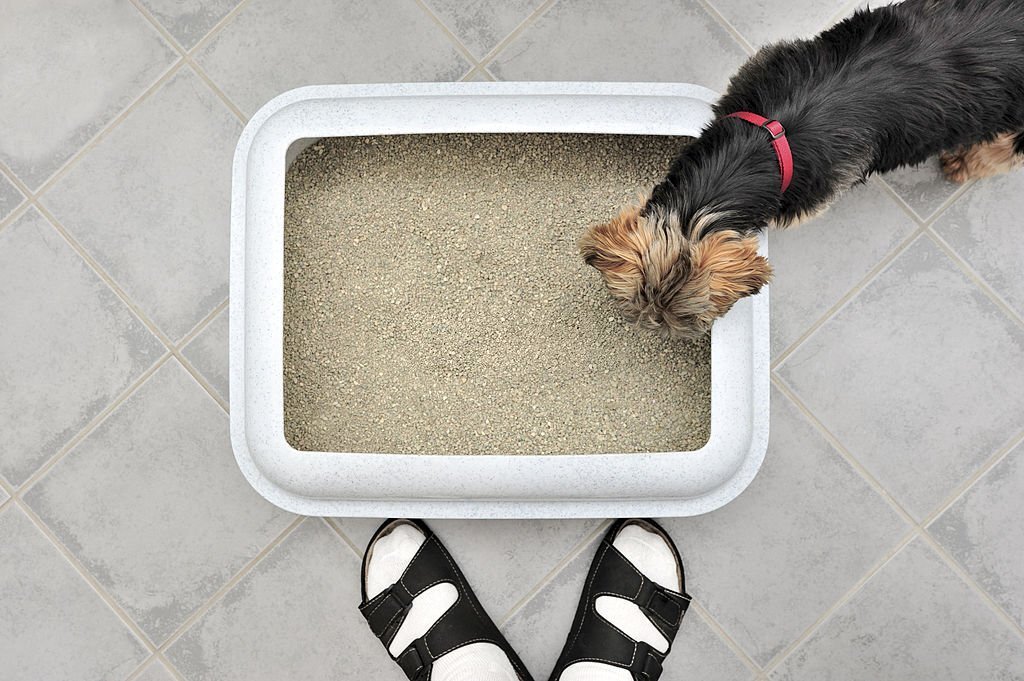
No responses yet